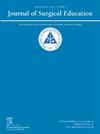“At the Table or Behind the Curtain”:A Randomized Study to Evaluate the Influence of Students’ Position in Theatre-Based Learning
IF 2.6
3区 医学
Q1 EDUCATION, SCIENTIFIC DISCIPLINES
引用次数: 0
Abstract
OBJECTIVES
The influence of students’ positioning within the theatre on their learning progress is unknown. The present study aimed to investigate whether position of undergraduate medical students in the operating theatre—at the operating table or behind surgical drapes—influences their learning.
DESIGN SETTING AND PARTICIPANTS
We conducted a single-blind prospective randomized study with 2 parallel arms. Undergraduate medical students allocated to the operating theatre in the course of the regular surgical curriculum were invited to participate. Participants were randomly assigned to either a position at the operating table, or behind surgical drapes during a visit to the operating theatre. After surgery, the students prepared sketches of essential procedural steps, which were evaluated by 3 independent surgeons using a predefined scoring system in a blinded fashion. Additionally, students were asked to answer a questionnaire for comparative self-assessment of pre- and postvisit knowledge concerning 4 aspects: routines within the theatre, sterile behaviour, essential procedural steps of the surgery and insight into the work of a surgical resident.
RESULTS
In total, 84 sketches and questionnaires (= 42 surgeries) were evaluated. Sketches prepared by the group positioned at the operating table reached significantly higher scores with regard to the essential procedural steps of the surgery (p = 0.012). Comparative self-assessment revealed a significant learning progress, with no significant difference between the groups.
CONCLUSIONS
Visiting the operating theatre significantly improved undergraduate medical students’ understanding of procedural steps and theatre-specific routines regardless of the position within the theatre. However, specific knowledge of surgical procedures is significantly was enhanced when students are positioned at the operating table rather than behind the surgical drapes. Appropriate structures, enabling involvement of students directly at the operating table, should be enforced in hospitals partaking in undergraduate surgical education.
求助全文
约1分钟内获得全文
求助全文
来源期刊

Journal of Surgical Education
EDUCATION, SCIENTIFIC DISCIPLINES-SURGERY
CiteScore
5.60
自引率
10.30%
发文量
261
审稿时长
48 days
期刊介绍:
The Journal of Surgical Education (JSE) is dedicated to advancing the field of surgical education through original research. The journal publishes research articles in all surgical disciplines on topics relative to the education of surgical students, residents, and fellows, as well as practicing surgeons. Our readers look to JSE for timely, innovative research findings from the international surgical education community. As the official journal of the Association of Program Directors in Surgery (APDS), JSE publishes the proceedings of the annual APDS meeting held during Surgery Education Week.
 求助内容:
求助内容: 应助结果提醒方式:
应助结果提醒方式:


